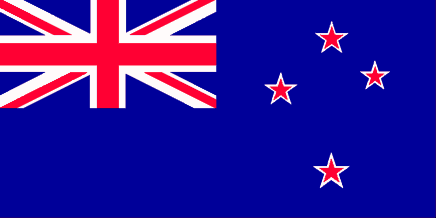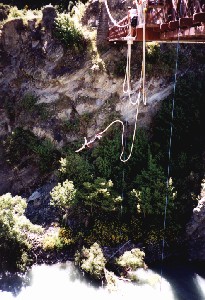
9 December 2002
Today we are going kayaking. After breakfast we are being picked up
by Jeff from Alpine River Guides,
who will lead us over the Clutha River. We are absolute beginners and therefore
we choose a grade II
river. Reasonably fast flowing with a couple of nice rapids. The weather is
perfect: sunny and some 20°C (68°F) or more. Erik does not fit into the
largest size kayak and that's why Claire, Jeff's wife has to drive home to fetch
a special type of kayak which you sit on in stead of sit in. I fit perfectly
into my kayak and after a trial run of tumble-over-and-get-out-of-the-kayak,
we are on our way. The beginning is fairly easy. Then follow a couple of
rapids with waves, but we manage them well. Even the "Washing Machine"
and the "
 Mother Rapid"
do not tumble us over. Jeff is a good guide and instructor, giving us useful
tips and encouragement. After a good 2,5 hours it is all over. Jeff brings us
back to Wanaka where we have lunch.
Mother Rapid"
do not tumble us over. Jeff is a good guide and instructor, giving us useful
tips and encouragement. After a good 2,5 hours it is all over. Jeff brings us
back to Wanaka where we have lunch.
We
spend the afternoon touring the Otago region. First to Cromwell (boring and called that to spite the Irish immigrants)
and Bannockburn, where we taste some wine at the
Mt Difficulty winery.
On we go towards the old Kawarau bridge, where you can do the original bungy jump
at AJ Hackett. The jumpers get a
certificate, a T-shirt and against extra payment even a video-recording. We just
watch others master their death fears and jump into the deep river gorge. The
spectators can watch it all from specially built platforms. We move on via the Crown Range Road
back to Wanaka.
This is the highest Main Route of New Zealand (at 1120m/3360ft alt.) and it
takes us past Cardrona where the Cardrona hotel
is a witness to the days of the Goldrush. Its front is in arrested decay while
the hotel behind it, is completely refurbished. Next to it is the old post
office and general store (not accessable).
In Wanaka we eatMexican at Amigas. .
10 December 2002
After a dismal breakfast at Kai Whakapai (scrambled eggs gone wrong
and stone hard toast) we carry on via the
Crown Range Highway to Arrowtown. This
small town still retains some of the Gold
rush heritage. This shortlived gold rush started when one Willam Fox found here
the first gold in 1862 and lasted for about 10 years. At its peak Arrowtown had
about 7,000 inhabitants, only 1,200 remain today. The main street of the old
centre consists of wooden houses and window signs from days past. It bit further
on is the former Chinese settlement. It shows the dark side of the goldrush
era. The Chinese had to live seperately during the goldrush is tiny ramshackle
huts.
They were discriminated against, earned half the wages that Europeans got for
the same work and had a hard time. Most of them returned to China (more or less
forcibly), but without the riches they had imagined when they set out for New
Zealand. The Chinese settlement was deserted at the time but since about 15
years ago it is kept in a state of arrested decay.
It has been raining all morning, but after Arrowtown the sky starts
clearing. We drive further south, passing Queenstown, and south along
Lake Wakatipu. With the clearing clouds and the high mountains around it, the
lake makes a fine introduction into Southland. The road to Te Anau in Fiordland is
still very long. ![]() After Queenstown another 170 km (106 mi). Here too, the country is very empty of
people. We come across only a few tiny hamlets before we finally reach Te Anau in Fiordland
on the lake with the same name. We stay at the YHA-hostel. The town is none too
big and not very specially beautiful (like most NZ small towns) and totally
geared at tourism. Lots of accommodation, a fair number of restaurants and
various outfits for tours and trips, most of them to the Sounds or fiords.
After Queenstown another 170 km (106 mi). Here too, the country is very empty of
people. We come across only a few tiny hamlets before we finally reach Te Anau in Fiordland
on the lake with the same name. We stay at the YHA-hostel. The town is none too
big and not very specially beautiful (like most NZ small towns) and totally
geared at tourism. Lots of accommodation, a fair number of restaurants and
various outfits for tours and trips, most of them to the Sounds or fiords.
At
night we have dinner at the
Radcliff Café & Bar. Very tasteful and imaginative dishes in
quiet setting.
Later at night we return for a performance of guitarist/singer
Ben Fulton, who is on his summer tour. Nice passionately sung songs. Pitty that
most of guests at the bar keep on babbling away during the performance.
11 December 2002
We have breakfast at the Bakery and drive to Manapouri on the lake
with the same name. Here we board a boat for a cruise to Doubtful Sound
with Real Journeys. That is to
say, we first cross Lake Manapouri. This is New Zealand's fifth largest lake and
second deepest lake. On the other side of the lake we get on a bus, which takes
us across the
Wilmott pass, through rainforests. The forest is densely grown with ferns, beech
and rimu. The ride is over one New Zealand's most remote roads. It does not
connect to any other road and only links Lake Manapouri to Doubtful Sound.
The sky is overcast and it rains quite a bit. The Doubtful sound is partly
shrouded in the clouds. It is the second longest fjord of 14 fjords in this
area. It is 430 m / 1300ft deep at its deepest point. We board another vessel
which will take us over the Sound. This sound is actually a fjord, as it is
formed by a glacier and not by a river. On the sound the views of the green
mountains is impressive.
Because of the large quantities of rain that fall here most days, there are
countless waterfalls carrying the rainwater into the sound. We sail some 40 km
(26 mi) down the sound towards the sea. We do not actually go out to sea because
of the high waves today. We do notice this when get close to the sea and the
ships starts to roll more than we care for. Meanwhile we have eaten most of our
lunch boxes that we ordered with our ticket. We return through a couple of
branches of the sound. On our way we see a number of fur seals and - quite
luckily - a pod of some 10 Bottlenose Dolphins. These are quite a bit taller
than the Dusky Dolphins we swam with in Kaikoura. (up to 3 metres or 10 ft).
They frolic playfully in the water. We are not supposed to clap or whistle to
get their attention, as this is against regulations. After having enjoyed the
animals' company for a while we move on to the starting point of the cruise at
Deep Cove.
There we still have to do a visit to the power station. This power
station makes use of the difference in altitude between Lake Manapouri and
Doubtful Sound. Within the mountains channelsl have been drilled and turbines
have been installed to generate electrical power. Through a tunnel that spirals
its way into the mountain we reach the power station itself. Interesting enough
in itself, but after a day full of natural wonders not too fascinating. Then
follows the last leg over Lake Manapouri back to the mainland.
We drive back to Te Anau where we have dinner at La Toscana. Good
Italian food. Filled to the last inch we leave the place and head for a late
night drink at the Radcliff bar.
Te Anau - Dunedin: 290 km (181 mi)
12 December 2002
Today we
drive to
Dunedin. This route takes us across
the South Island again to the East Coast. It's fairly reasonable weather and the
journey goes well. Closer to Dunedin it gets more cloudy and it starts raining.
We find our B&B, the Albatross
Inn without much trouble. It is a nice enough place, but some of the furniture
is badly in need of replacement. Big plus is the free internet access. We have
lunch in a downtown café (Capers) on George St. We explore the city centre. The
railway station dates from the late 19th century and is beautifully kept. Inside
is the real surprise: rich decorations of china and majolica made especially by
Royal Doulton in Britain. The central square in Dunedin is the Octago
n,
not surprisingly an octagonal area. Here are the city hall, St Paul's Cathedral
and the Regent Theatre. In the City Hall is also the Tourist information centre.
The cathedral is nice, dating back to 1909 with an abse from 1971. A bit
further on is the First Church. A Scottish presbytarian church from the same
period. All these buildings are in the same grey stones that remind us of Edinburgh
in Scotland. Dunedin makes a lot of its Scottish heritage. It owes its name to
the Scottish capital too. Scotland is around us everywhere. There are many
Scottish shops - even kilt makers - and Scottish flags can be seen on many a flag
pole. The shops close a bit early, around five.
At night we eat at Abalone, a trendy restaurant and bar, with good food.